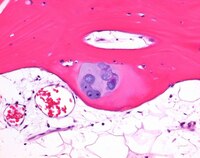101736 Sigma-AldrichOSTEOMOLL®
Recommended Products
Przegląd
| Replacement Information |
|---|
Products
| Numer katalogowy | Opakowanie | Ilość/opak. | |
|---|---|---|---|
| 1017361000 | Butelka plastikowa | 1 l | |
| 1017362500 | Butelka plastikowa | 2.5 l |
| References |
|---|
| Product Information | |
|---|---|
| HS Code | 3824 99 92 |
| Quality Level | MQ400 |
| Applications | |
|---|---|
| Application | Solution for rapid decalcification (with fixation) for histology |
| Biological Information |
|---|
| Physicochemical Information | |
|---|---|
| Density | 1.10 g/cm3 (20 °C) |
| pH value | 1 (H₂O, 20 °C) |
| Dimensions |
|---|
| Materials Information |
|---|
| Toxicological Information |
|---|
| Safety Information | |
|---|---|
| Categories of danger | substancja szkodliwa, substancja dra?ni?ca, substancja rakotwórcza, substancja uczulaj?ca |
| Product Usage Statements |
|---|
| Storage and Shipping Information | |
|---|---|
| Storage | Przechowywać w +15°C do +25°C. |
| Packaging Information |
|---|
| Supplemental Information |
|---|
| Specifications | |
|---|---|
| Performance test | passes test |
| Global Trade Item Number | |
|---|---|
| Numer katalogowy | GTIN |
| 1017361000 | 04022536929026 |
| 1017362500 | 04027269233082 |
Documentation
OSTEOMOLL® MSDS
| Title |
|---|
OSTEOMOLL® Certificates of Analysis
| Numer katalogowy | Opakowanie | Specyfikacja | Numer partii |
|---|---|---|---|
| 1017361000 | Butelka plastikowa | Dokument ze specyfikacją, w formacie PDF | |
| 1017362500 | Butelka plastikowa | Dokument ze specyfikacją, w formacie PDF |
User Guides
| Title |
|---|
| User Guide (IFU) - 1.01736 |










